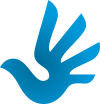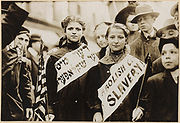
Children's rights movement
Background Information
SOS Children made this Wikipedia selection alongside other schools resources. Click here to find out about child sponsorship.
| Rights |
|---|
 |
|
Theoretical distinctions
|
|
Human rights
|
|
Other groups of rights
|
The Children's Rights Movement is a historical and modern movement committed to the acknowledgment, expansion, and/or regression of the rights of children around the world. While the historical definition of child has varied, the United Nations Convention on the Rights of the Child explains, "A child is any human being below the age of eighteen years, unless under the law applicable to the child, majority is attained earlier." There are no definitions of other terms used to describe young people such as " adolescents", "teenagers" or " youth" in international law.
History
Thomas Spence's The Rights of Infants (1796) is an early English-language assertion of the natural rights of children.
In the USA, the Children's Rights Movement was born in the 19th century with the orphan train. In the big cities, when a child's parents died or were extremely poor, the child frequently had to go to work to support himself and/or his family. Boys generally became factory or coal workers, and girls became prostitutes or saloon girls, or else went to work in a sweat shop. All of these jobs paid only starvation wages.
In 1852, Massachusetts required children to attend school. In 1853, Charles Brace founded the Children's Aid Society, which worked hard to take street children in. The following year, the children were placed on a train headed for the West, where they were adopted, and often given work. By 1929, the orphan train stopped running altogether, but its principles lived on.
The National Child Labor Committee, an organization dedicated to the abolition of all child labor, was formed in the 1890s. It managed to pass one law, which was struck down by the Supreme Court two years later for violating a child's right to contract his work. In 1924, Congress attempted to pass a constitutional amendment that would authorize a national child labor law. This measure was blocked, and the bill was eventually dropped. It took the Great Depression to end child labor nationwide; adults had become so desperate for jobs that they would work for the same wage as children. In 1938, President Franklin D. Roosevelt signed the Fair Labor Standards Act which, amongst other things, placed limits on many forms of child labor.
Now that child labor had been effectively eradicated in parts of the world, the movement turned to other things, but it again stalled when World War II broke out and children and women began to enter the work force once more. With millions of adults at war, the children were needed to help keep the country running. In Europe, children served as couriers, intelligence collectors, and other underground resistance workers in opposition to Hitler's regime.
Present
In the early 20th century, moves began to promote the idea of children's rights as distinct from those of adults and as requiring explicit recognition. The Polish educationalist Janusz Korczak wrote of the rights of children in his book How to Love a Child (Warsaw, 1919); a later book was entitled The Child's Right to Respect (Warsaw, 1929). In 1917, following the Russian Revolution, the Moscow branch of the organization Proletkult produced a Declaration of Children's Rights. However, the first effective attempt to promote children's rights was the Declaration of the Rights of the Child, drafted by Eglantyne Jebb in 1923 and adopted by the League of Nations in 1924. This was accepted by the United Nations on its formation and updated in 1959, and replaced with a more extensive UN Convention on the Rights of the Child in 1989.
From the formation of the United Nations in the 1940s and extending to present day, the Children's Rights Movement has become global in focus. While the situation of children in the United States has become grave, children around the world have increasingly become engaged in illegal, forced child labor, genital mutilation, military service, and sex trafficking. Several international organizations have rallied to the assistance of children. They include Save the Children, Free the Children, and the Children's Defense Fund.
The Child Rights Information Network, or CRIN, formed in 1983, is the group of 1,600 non-governmental organizations from around the world which advocate for the implementation of the Convention on the Rights of the Child. Organization's report on their countries' progress towards implementation, as do governments that have ratified the Convention. Every 5 years reporting to the United Nations Committee on the Rights of the Child is required for governments.
United States
While there is a long history of children's rights in the U.S., scholars contend that there is no " golden age". Many children's rights advocates in the U.S. today advocate for a smaller agenda than their international peers. Groups predominately focus on child abuse and neglect, child fatalities, foster care, youth aging out of foster care, preventing foster care placement, and adoption. A longstanding movement promoting youth rights in the United States has made substantial gains in the past.
United Kingdom
Anti-Children's Rights propagandists often raise the spectre of Rights without Responsibilities. The Children's Rights Movement assert that it is rather the case that children have rights which adults, states and government have a responsibility to uphold. The UK maintains a position that UNCRC is not legally enforceable and is hence 'aspirational' only - albeit a 2003 ECHR ruling states: "The human rights of children and the standards to which all governments must aspire in realizing these rights for all children are set out in the Convention on the Rights of the Child." (Extract from Sahin v Germany, Grand Chamber judgment of the ECHR, July 8, 2003). 18 years after ratification, the four Children's Commissioners in the devolved administrations have united in calling for adoption of the Convention into domestic legislation, making children's rights legally enforceable.
Ombudsmanship
Several countries have created an institute of children's rights ombudsman, most notably Sweden, Finland and Ukraine, which is first country worldwide to install children at that post. In Ukraine Ivan Cherevko and Julia Kruk became first children's rights ombudsmen in late 2005.
Convention on the Rights of the Child
The United Nations Convention on the Rights of the Child has outlined a standard premise for the children's rights movement and has been ratified by all but two nations - the United States and Somalia. Somalia's inability to sign the Convention is attributed to their lack of governmental structure. The US administration under Bush has opposed ratifying the Convention because of "serious political and legal concerns that it conflicts with U.S. policies on the central role of parents, sovereignty, and state and local law." However, the new administration may be taking another look at it.

